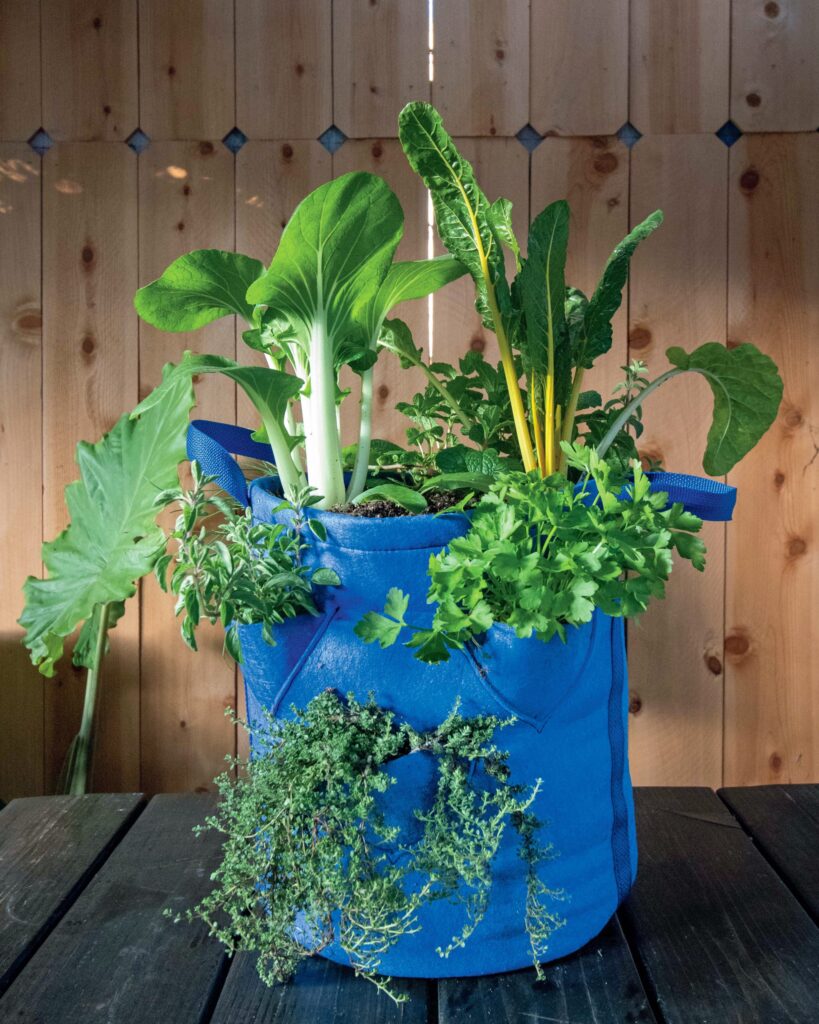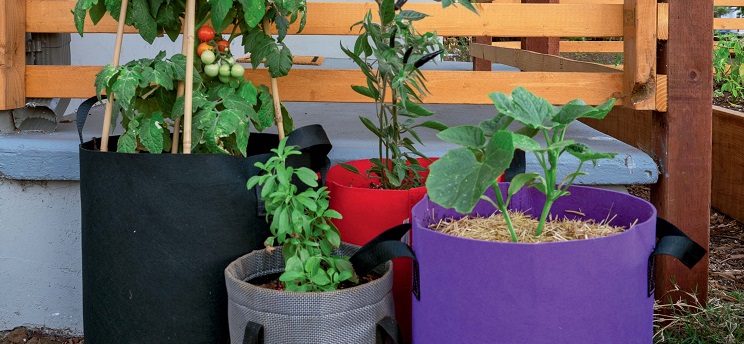If you tend to grow your tomatoes and other vegies in unsightly plastic grow bags, it might be time to think again.
Self-taught gardener Kevin Espiritu, author of a new book, Grow Bag Gardening, offers a wealth of different growing ideas for alternative fabric grow bags, rather than just the typical black plastic ones.
He says that most available fabric grow bags “are made from recycled plastic, which at the very least means they’ve already gone through the recycling process once and will last for quite a while”. Meanwhile, you’ll be able to track down others made of jute or hessian, which will degrade over time.
The advantages of grow bags
You’ll be able to find grow bags in an array of shapes and sizes, from circular to rectangular and multi-pocketed, which will accommodate the smallest space on a balcony or a tiny garden. They’re great for renters as they’re easy to move and cheaper than terracotta and other decorative containers.
“Their portability, flexibility and air pruning benefits effectively delete the downsides of growing in containers that many gardeners face,” Mr Espiritu observes. While plants that outgrow their pots end up with a mass of roots circling the base of the plant, if you use a permeable grow bag, the roots get an air-rich environment low in water and nutrients. This causes the tips of the roots to die, signalling the plant to produce new roots elsewhere in the root system, he explains, which extends the length of time a plant can be grown in a grow bag before it needs repotting.
Of course, if you’re using grow bags on a balcony or on surfaces you don’t want the water to seep onto, place the bag on a high-sided terracotta tray or saucer to catch excess moisture, or custom make a reservoir from a wooden crate lined with pond liner to accommodate a number of bags.
Read more: Gardening on a budget
Here, Mr Espiritu offers gardeners with even the smallest spaces some ideas on how to make the most of their grow bags.
1. Stir-fry grow bag

Create your own stir-fry ready bag of veg and greens. “I have one now where you can grow sage, thyme, oregano, coriander and basil – then on the top I have Asian greens including pak choi, Asian mustard, so I could make a quick stir-fry simply from that bag, which takes up very little space. If you’re a small-space gardener, that’s a really good bet. That bag would take around 30 litres of compost.
“If some of your herbs, like coriander, bolt (run to seed), it’s easy to replenish. As you are cramming so many plants in one bag, harvest them more often, gently pull them out and plant a replacement into the pocket, so you can succession-plant as the season progresses.
“Alternatively, plant herbs that are likely to bolt in their own bags, to place in a shadier spot during hot weather, to stop them bolting so quickly.”
2. Fruit tree in a bag
“If you are in a relatively cold area, grow a citrus, which you could move in and out fairly easily in a grow bag. To grow a fruit tree, you’d need a big bag that would hold around 100 litres of compost. I would recommend buying a tree that’s on dwarfing rootstock, which is more naturally a small plant. They will live happily in a grow bag for around a decade, I reckon.
“With fruit trees you would need to top dress and feed with a granular fertiliser, because if you use soluble fertiliser and then water, you’ll water the nutrients right out of the bag, which is permeable. I would even mulch the surface with leaves or compost to protect the layer.”
3. Mini allotment
“If you are a renter with a small back garden, you can roll out a large grow bag and build a raised bed in seconds. I like making an artistic vegetable garden, so I have Chinese cabbage in the middle and mizunas in different colours at the sides and it almost looks like a little art piece.”
Read more: Mistakes to avoid when growing vegies in containers
4. Multiple mints and strawberries
“Mints are invasive, so you need to plant them on their own. I’d take a couple of varieties and plant them all together, then at least they won’t colonise anything else, so you could have a variety of minted teas or leaves to add to salads.
“Or you could plant strawberries, which throw out a lot of runners, in an individual grow bag, so they don’t take over a whole patch of ground.”
5. Balcony climbers

“Grow vertically in a small space, adding bamboo trellises or canes into the grow bag, growing peas, sweet peas and ornamental climbers as well as French and runner beans. You’d only need as much soil as you would in a standard container, but the grow bag will be much lighter.”
6. Perfect for pollinators
“Grow bags can also fill spaces in your border as the season progresses. Fill your grow bag with nectar-rich plants to attract insects to the bed.
“Typically, in a small space you want to grow food, but in a larger garden you may want flowers too. I place good plants for pollinators in grow bags near the vegetables, which should encourage insects to pollinate the flowers and give me better crops.
Read more: How to get the best harvest from five of our favourite vegies
“So, if I have tomatoes or cucumbers that need more pollination, I group grow bags of pollinator-attracting plants that I can move at will. Nasturtiums will bring in larger pollinators like bees, but they also attract aphids away from your vegetable plants.”
Grow Bag Gardening by Kevin Espiritu is published by Cool Springs Press, available now.
Do you have a grow bag or container garden? What vegies do you grow?
– With PA
If you enjoy our content, don’t keep it to yourself. Share our free eNews with your friends and encourage them to sign up.

